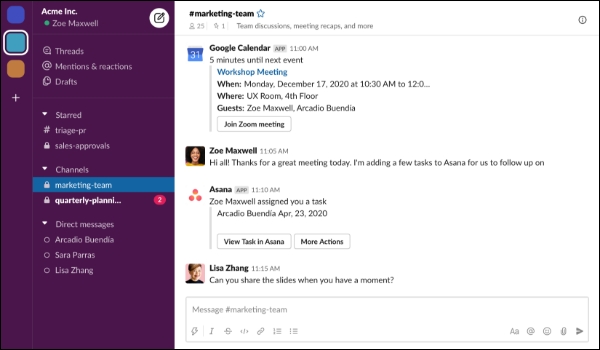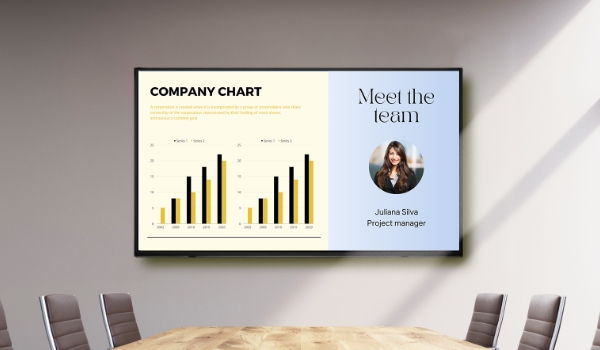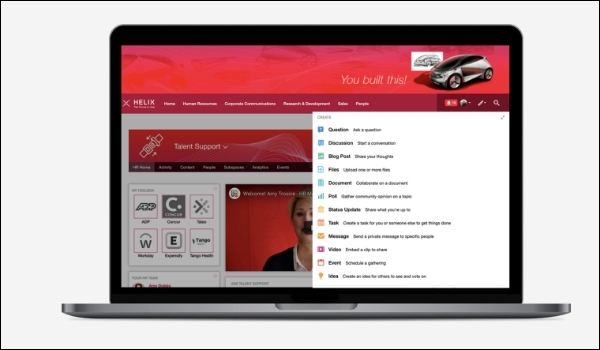
Nov 30 2022
9 min read


Jul
The workplace we know today is different from what the earlier generations knew.
A few things have changed.
For starters, globalization has opened doors to overseas collaboration, making internal communication a borderless, proximity-defying affair.
Secondly, the pandemic has positioned the atypical working models of work-from-home, freelancing gigs, and hybrid hours as practical solutions.
A part of your team is working remotely; a few employees are even sitting in a different time zone, and you, as an HR manager or the communications officer, have to ensure seamless communication from the top-down to bottom-up and sideways.
You need to have an internal communication plan and utilize the best internal communication tools available.
An internal communication plan helps coordinate the activities of every unit within a corporate structure. The larger the company, the greater the need for an effective communication action plan.
In modern internal comms, technology has a prominent role to play. Nowadays, several useful internal communication tools can facilitate team collaborations and top-down messaging and help bring transparency to communication.
The internal communication strategy is created with the objective of achieving a broader goal. For example, increasing the company’s gender diversity by 2%.
On the other hand, the internal communication plan is a more detailed, Tactical plan for short-term goals. For example, An internal communication plan within the above strategy will have goals like:
Finding out the current male-to-female ratio of employees
Conducting an internal survey to determine what percentage of female employees are interested in leadership roles.
Encouraging more female candidates to apply for leadership positions
Once the internal communication strategy is clear, the communications team can outline an internal communication plan.
Identifying your target audience is essential for an effective internal communication strategy. This is imperative because, if you don’t know your audience well, your messages might lose their meaning. Without a focus on an audience, there is a risk of losing the strategic essence of internal communications. Figuring out your target audience refers to looking into what kind of experiences have they had, what are their expectations, and how much of the message are they able to comprehend.
Internal communication, irrespective of whether external or internal, is important that it is understood by the audience. When your messages match the expectations of the audience, it helps build trust in your organization.
It also builds strong connections and makes sure everyone understands each other.
If you could map all the internal communications with an organization, it would look as complex as the geographical map of a busy city. There are highways that allow long-distance delivery of packages. There are small alleys for quick movement between streets and houses.Route planner apps apps can help to simplify the navigation of these communications and make it as easy as finding the quickest route in a city.
So, within your organization, you can compare the critical messages (policy updates, events, etc.) as those cargo-delivered packages that journey over the highways. These messages have to be circulated across all the departments (often at national or multinational scale) and delivery needs to be ensured. Similarly, there can be instant communications like birthday wishes, daily team communications, and newsletters that will involve a constant flow of information.
The objective of a communication strategy is to prioritize, organize and streamline the flow of communication in the direction of the organization’s goals. An internal communication strategy may involve plans regarding:
Employer-employee communication
Employee-employee communication, etc.
Your internal communication strategy will depend on your organization’s goals. However, the following examples can provide a rough blueprint of what to expect from a winning internal communication strategy.

This goes mainly for small to medium-sized organizations. You must have an agenda in your internal communication plan that discourages the use of emails for daily work-based transmissions and reporting.
Do you know why I insist on that?
Because every Tom, Dick, and Harry knows your official email addresses and sends you thousands of promotional, sales-y messages daily. Every app you sign up for sends notifications, verification emails, newsletters, and whatnot!
Now see this message:

This message is important. But amidst the stockpile of garbage promotions and updates, Emily might just miss reading it.
Day-to-day internal communications should be carried out over a company’s private messaging apps like Slack, Discord, Google Hangouts, or Hives. Most of these apps have excellent internal communication features like quick video calling, voice messaging, digital whiteboards, and more.
Example IRL: Pickcel
At Pickcel, we have a hybrid workforce with employees from all four corners of the world. For our daily internal communications, our teams use Slack. This allows us quick resolution of problems and space for collaborative brainstorming, easy transfer of files, and timely birthday & meeting reminders. We can create multiple chat rooms with different teams for discussions on different projects.
If your internal comm materials are overflowing with words, you must change your approach. In this busy age, expecting employees to read prosaic messages is as good as asking them to keep financials noted on a physical ledger. Studies have shown that people retain 95% of video messages compared to only 10% of textual communications.
Infographics, images, videos, GIFs, slideshow presentations, and comic storyboarding are some interesting examples of visual communication that you can incorporate into your organization’s internal comm plan. Visual communication is also a fantastic tool in microlearning initiatives for employees.

One of the key objectives of any internal communication strategy is optimizing internal communication within an organization. Optimizing internal communication means employees have information at their fingertips. Digital signage can be a handy tool for optimizing workplace communications.
The versatility of digital signage can be exploited for both cases: engaging by entertaining and engaging by informing. The digital screen in your office can show a wide range of content, such as:
Welcome messages to visitors and new employees
Employee wall of Fame
Meeting timetables
Conference room availability
Industry news and RSS feeds
Business intelligence and KPI dashboards
Sales and project management dashboard
Events live stream
Virtual meetings
General infotainments like live weather, AQI, traffic maps, digital clocks
Employer branding content like CSR videos, company mission and vision statements, messages from the CEO, etc.
We live in a time when technology is present across the length and breadth of any organization’s success strategy. It is only natural that technology has a role to play in your internal communication plans as well.
Example IRL: Mercedes Benz
Mercedes uses Pickcel's digital signage software for their internal corporate communications. Integrating their dashboards with the software, the management can use it to display real time business intelligence data and keep their employees updated with work progress. Read the full case study.

As a graphic designer, you may have very little knowledge about the feedback your sales team just received from a lead. As a backend developer, you may be unaware of the new client your company closed a deal with yesterday.
As an HR or communications manager, this is not good news for you.
When employees lack the bigger picture, they fail to grasp the importance of their role in the company. A weekly, monthly, bimonthly, or quarterly newsletter helps to keep all your staff members on the same page. Internal newsletters can be used to circulate updates, such as:
recent tech developments
new developments in the product
charts & graphs statistically assessing the frequency of queries, commonly-faced issues in the products, customer feedback, etc.
company growth and revenue data
upcoming events
special messages from the CEO and board of directors

The most efficient way to optimize internal comms is to develop a company intranet or a mobile workforce app. These are private platforms only for the workforce. They are great for:
employee onboarding through video tutorials
sending custom notifications to the employees (example: digital birthday cards, appreciation messages from the seniors)
specific services related to the organization’s domain (example: if you are a banking firm, your employees can use the employee app to access your banking services)
company-wide announcements like change in leadership or crisis messaging.
Example IRL: Coach Inc.
Coach Inc. is known to add a dash of innovation to everything, whether it is their immersive shop window displays or their corporate's internal communication strategies. The brand uses an intranet forum, 'CoachWeb,' to connect thousands of its retail store employees with the Coach corporate offices. Employees can connect with HRs, raise queries, get company updates, and more.
While developing your internal communication strategy, make sure that it is not a one-sided monologue. Your employees are experts in their fields; working at the grassroots level makes them erudite about your products and services, customers, and customer pain points. Internal surveys allow you to gather their intelligence and transform them into meaningful decision-making points.
You can conduct internal employee surveys to:
Learn about employee satisfaction and expectations
Identify job pain points
Encourage participation
Understand what motivates your employees
Include at least one annual employee internal survey in your internal communications strategy. Pulse employee surveys are also known to bring great results.

One of the biggest mistakes corporates make in their internal communication strategy is not having an agenda to know their employees better. And be better, we mean knowing them as humans, not human resources.
Not so surprisingly, some of the most successful businesses have leaders that not only know their employees’ full names but are also interested in knowing their personal development goals, family members, and family well-being.
While the leadership within larger organizations may find it impossible to foster such a degree of personal communication with all their employees, it is always good to build a personal rapport with the staff up to two ranks down the chain of command.
There are many ways in which you can build a personal rapport with your employees, such as:
Having one-to-one meetings
Employee-employer lunch or game sessions
Providing meet basis financial assistance
Being available at times of crisis
You have a clean internal communication strategy in place, you are armed and equipped with exciting newsletters, employee onboarding videos, and motivational quotes, and you send them out to the workforce.
Now what?
Now, you have to gauge the results.
Are your employees interacting with the organization’s messages?
Do they find the content helpful?
To measure the success of your internal communication action plan, you can use metrics like:
Message open rates
Intranet read receipts
Employee app downloads
Content views and shares
Login sessions and session duration
Employee turnover rates
Employee feedback
To understand your internal communication strategy’s effectiveness, you should have a baseline number for each KPI.
A solid internal communication strategy is crucial for driving an organization’s success. From faster collaboration on projects to talent retention, communication has a role to play in every aspect of your company’s growth. Whenever you develop an internal comm plan for your business, do make sure to integrate technology in it. We can guarantee you, the results will be sweet.

Take complete control of what you show on your digital signage & how you show it.
Start Free Trial Schedule My Demo
Nov 30 2022
9 min read

Nov 11 2022
8 min read

Oct 20 2022
5 min read

Sep 20 2022
12 min read